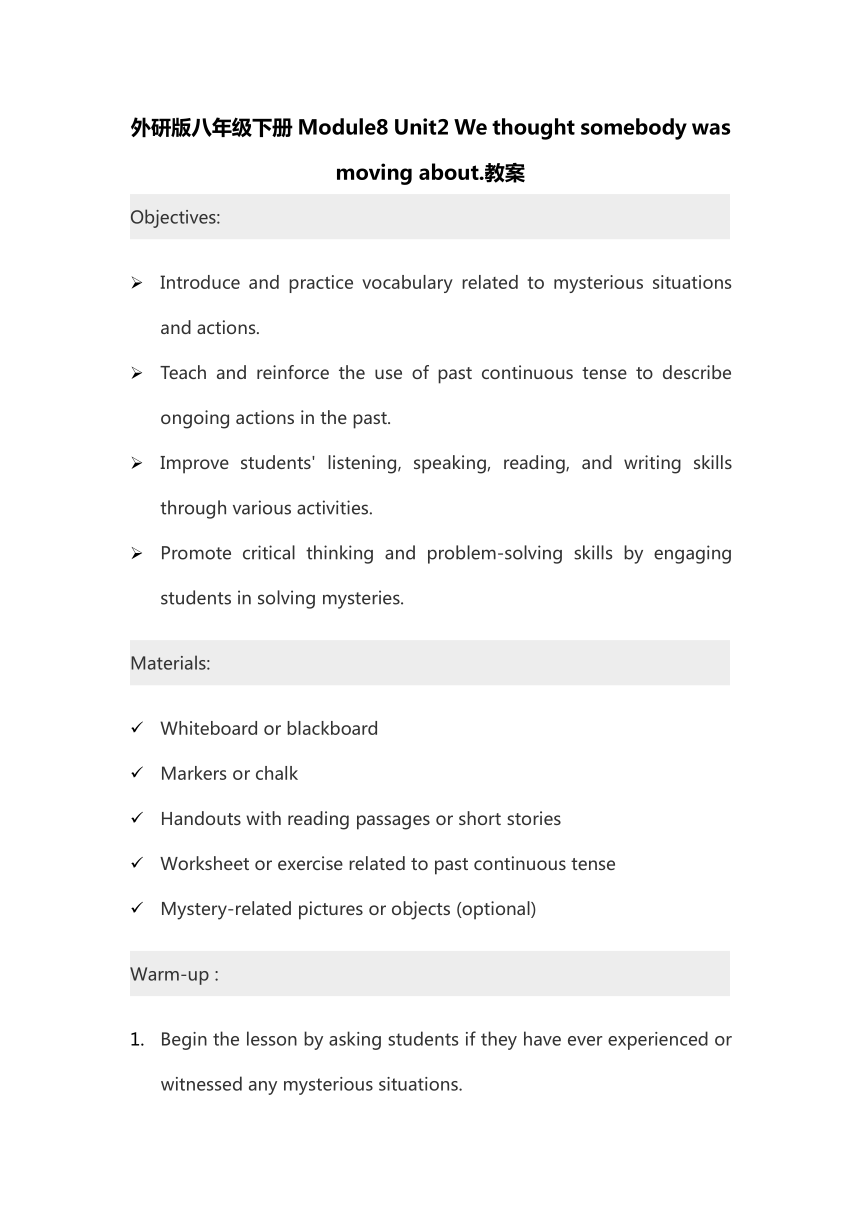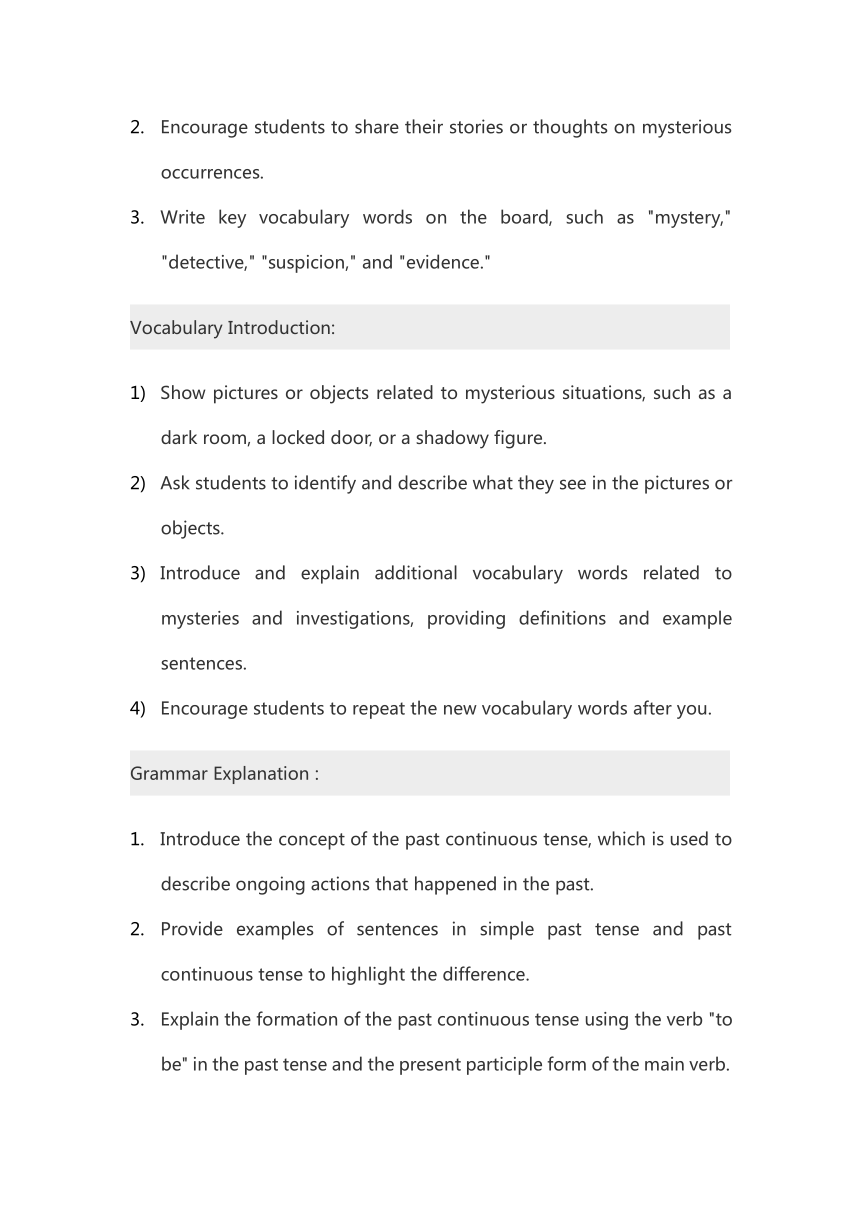Module 8 Unit 2 We thought somebody was moving about. 教案
文档属性
| 名称 | Module 8 Unit 2 We thought somebody was moving about. 教案 |  | |
| 格式 | docx | ||
| 文件大小 | 18.0KB | ||
| 资源类型 | 教案 | ||
| 版本资源 | 外研版 | ||
| 科目 | 英语 | ||
| 更新时间 | 2023-08-25 14:26:24 | ||
图片预览


文档简介
外研版八年级下册Module8 Unit2 We thought somebody was moving about.教案
Objectives:
Introduce and practice vocabulary related to mysterious situations and actions.
Teach and reinforce the use of past continuous tense to describe ongoing actions in the past.
Improve students' listening, speaking, reading, and writing skills through various activities.
Promote critical thinking and problem-solving skills by engaging students in solving mysteries.
Materials:
Whiteboard or blackboard
Markers or chalk
Handouts with reading passages or short stories
Worksheet or exercise related to past continuous tense
Mystery-related pictures or objects (optional)
Warm-up :
Begin the lesson by asking students if they have ever experienced or witnessed any mysterious situations.
Encourage students to share their stories or thoughts on mysterious occurrences.
Write key vocabulary words on the board, such as "mystery," "detective," "suspicion," and "evidence."
Vocabulary Introduction:
Show pictures or objects related to mysterious situations, such as a dark room, a locked door, or a shadowy figure.
Ask students to identify and describe what they see in the pictures or objects.
Introduce and explain additional vocabulary words related to mysteries and investigations, providing definitions and example sentences.
Encourage students to repeat the new vocabulary words after you.
Grammar Explanation :
Introduce the concept of the past continuous tense, which is used to describe ongoing actions that happened in the past.
Provide examples of sentences in simple past tense and past continuous tense to highlight the difference.
Explain the formation of the past continuous tense using the verb "to be" in the past tense and the present participle form of the main verb.
Practice constructing sentences in the past continuous tense together as a class.
Reading and Comprehension :
Distribute reading passages or short stories that involve mysterious situations and actions.
Instruct students to read the passages individually or in pairs and underline any verbs or phrases indicating ongoing actions in the past.
Facilitate a class discussion to check comprehension, asking questions about the characters, actions, and possible solutions to the mysteries.
Encourage students to use the past continuous tense to describe ongoing actions in the stories.
Speaking and Listening Activities :
Divide the class into pairs or small groups and assign each group a mystery scenario or picture.
Instruct students to create a dialogue or story based on the given scenario, using the past continuous tense to describe ongoing actions.
Encourage students to exchange their dialogues or stories and perform them for the class.
Provide feedback and engage in whole-class discussions about the different mystery scenarios.
Grammar Practice :
Provide a worksheet or exercise related to the past continuous tense.
Instruct students to complete the exercise individually or in pairs.
Review the answers as a class, discussing any questions or difficulties encountered.
Writing Activity :
Ask students to imagine they are detectives and have just solved a mysterious case.
Instruct them to write a short story or narrative describing the ongoing actions they observed during their investigation, using the past continuous tense.
Encourage students to incorporate their vocabulary knowledge and creativity to make their stories engaging and suspenseful.
Allow volunteers to share their stories with the class.
Conclusion:
Recap the key points of the lesson, including the vocabulary words and the use of the past continuous tense.
Discuss the importance of paying attention to ongoing actions and using the appropriate tense when describing past events.
Encourage students to continue practicing the past continuous tense in their speaking and writing.
Close the lesson with a brief reflection or discussion about the excitement and challenges of solving mysterious situations.
Objectives:
Introduce and practice vocabulary related to mysterious situations and actions.
Teach and reinforce the use of past continuous tense to describe ongoing actions in the past.
Improve students' listening, speaking, reading, and writing skills through various activities.
Promote critical thinking and problem-solving skills by engaging students in solving mysteries.
Materials:
Whiteboard or blackboard
Markers or chalk
Handouts with reading passages or short stories
Worksheet or exercise related to past continuous tense
Mystery-related pictures or objects (optional)
Warm-up :
Begin the lesson by asking students if they have ever experienced or witnessed any mysterious situations.
Encourage students to share their stories or thoughts on mysterious occurrences.
Write key vocabulary words on the board, such as "mystery," "detective," "suspicion," and "evidence."
Vocabulary Introduction:
Show pictures or objects related to mysterious situations, such as a dark room, a locked door, or a shadowy figure.
Ask students to identify and describe what they see in the pictures or objects.
Introduce and explain additional vocabulary words related to mysteries and investigations, providing definitions and example sentences.
Encourage students to repeat the new vocabulary words after you.
Grammar Explanation :
Introduce the concept of the past continuous tense, which is used to describe ongoing actions that happened in the past.
Provide examples of sentences in simple past tense and past continuous tense to highlight the difference.
Explain the formation of the past continuous tense using the verb "to be" in the past tense and the present participle form of the main verb.
Practice constructing sentences in the past continuous tense together as a class.
Reading and Comprehension :
Distribute reading passages or short stories that involve mysterious situations and actions.
Instruct students to read the passages individually or in pairs and underline any verbs or phrases indicating ongoing actions in the past.
Facilitate a class discussion to check comprehension, asking questions about the characters, actions, and possible solutions to the mysteries.
Encourage students to use the past continuous tense to describe ongoing actions in the stories.
Speaking and Listening Activities :
Divide the class into pairs or small groups and assign each group a mystery scenario or picture.
Instruct students to create a dialogue or story based on the given scenario, using the past continuous tense to describe ongoing actions.
Encourage students to exchange their dialogues or stories and perform them for the class.
Provide feedback and engage in whole-class discussions about the different mystery scenarios.
Grammar Practice :
Provide a worksheet or exercise related to the past continuous tense.
Instruct students to complete the exercise individually or in pairs.
Review the answers as a class, discussing any questions or difficulties encountered.
Writing Activity :
Ask students to imagine they are detectives and have just solved a mysterious case.
Instruct them to write a short story or narrative describing the ongoing actions they observed during their investigation, using the past continuous tense.
Encourage students to incorporate their vocabulary knowledge and creativity to make their stories engaging and suspenseful.
Allow volunteers to share their stories with the class.
Conclusion:
Recap the key points of the lesson, including the vocabulary words and the use of the past continuous tense.
Discuss the importance of paying attention to ongoing actions and using the appropriate tense when describing past events.
Encourage students to continue practicing the past continuous tense in their speaking and writing.
Close the lesson with a brief reflection or discussion about the excitement and challenges of solving mysterious situations.
同课章节目录
- Module 1 Feelings and impressions
- Unit 1 It smells delicious.
- Unit 2 I feel nervous when I speak Chinese .
- Unit 3 Language in use
- Module 2 Experiences
- Unit 1 I've also entered lots of speaking competi
- Unit 2 They have seen the Pyramids.
- Unit 3 Language in use
- Module 3 Journey to space
- Unit 1 Has it arrived yet?
- Unit 2 We have not found life on any other planet
- Unit 3 Language in use
- Module 4 Seeing the docto
- Unit 1 I haven't done much exercise since I got m
- Unit 2 We have played football for a year now
- Unit 3 Language in use
- Module 5 Cartoons
- Unit 1 It's time to watch a cartoon.
- Unit 2 Tintin has been popular for over eighty yea
- Unit 3 Language in use
- Revision module A
- Module 6 Hobbies
- Unit 1 Do you collect anything ?
- Unit 2 Hobbies can make you grow as a person.
- Unit 3 Language in use
- Module 7 Summer in Los Angeles
- Unit 1 Please write to me and send me some photos
- Unit 2 Fill out a form and come to learn English
- Unit 3 Language in use
- Module 8 Time off
- Unit 1 I can hardly believe we are in the city ce
- Unit 2 We thought somebody was moving about
- Unit 3 Language in use
- Module 9 Friendship
- Unit 1 Could I ask if you've mentioned this to he
- Unit 2 I believe that the world is what you think
- Unit 3 Language in use
- Module 10 On the radio
- Unit 1 I hope that you can join us one day
- Unit 2 It seemed that they were speaking to me in
- Unit 3 Language in use
- Revision module B
